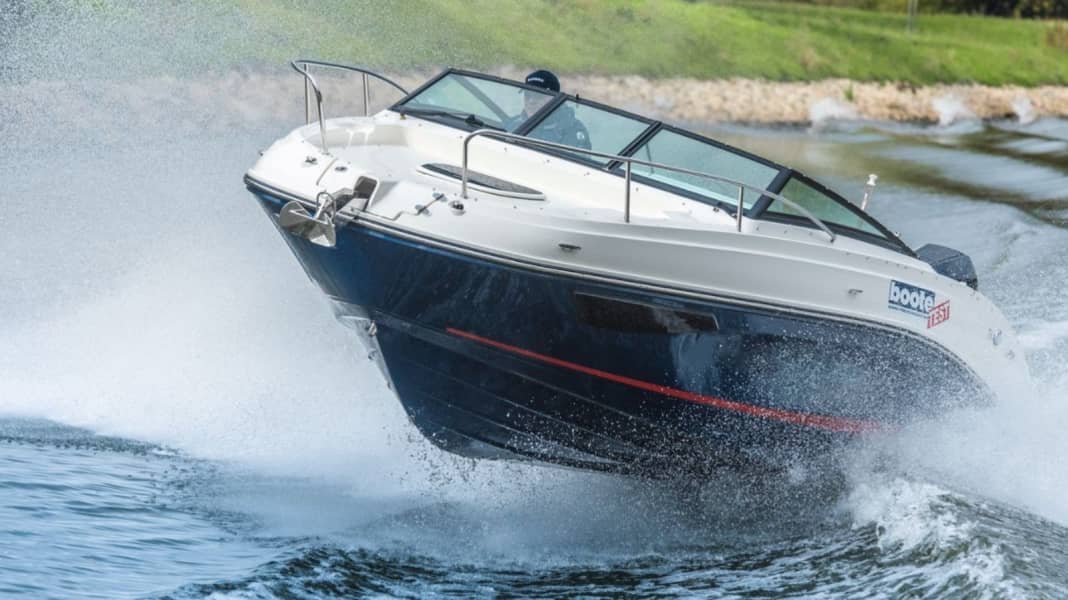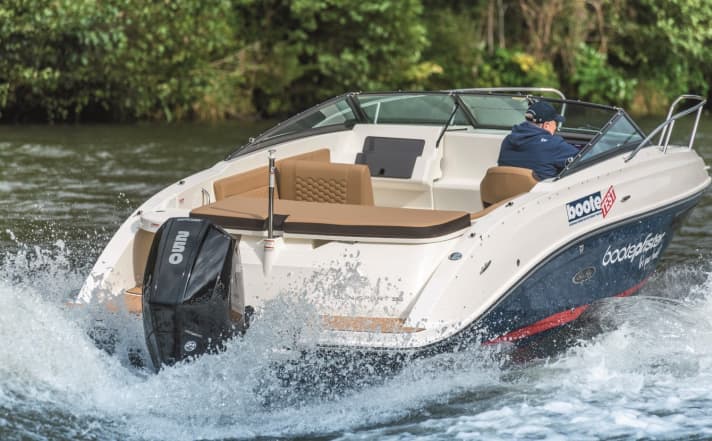
Sea Ray has over sixty years of boatbuilding history. The boats used to be manufactured exclusively in the USA, but now there is also a production facility in Europe. This is where our test boat, the Sea Ray 230 SSOE, comes from - the "E" stands for Europe.
The boat is a so-called cuddy and offers a spacious cockpit with plenty of room for sitting and sunbathing. So that the crew can also be supplied with cool drinks, there is an ice box or, as on our test boat, an additional fridge drawer for an extra charge. If you want a coffee, you can make it on a Wallas cooker on the starboard side, which also includes a small sink for washing dishes and hands; both cost extra, as does the stern shower. In contrast, the standard bathing ladder on the split bathing platform on the port side, where there is a stern passageway, is different. This can be opened in no time at all: simply remove the corner cushions and fold up the head section of the rear lounger.
In the foredeck there is a cabin with a V-berth and a chemical toilet. The latter is conveniently located in a storage space under the cockpit floor and can be pulled into the cabin's footwell. There are stowage boxes under the cushions, which, for example, hold the round cockpit table and support tube in a special holder. A large emergency hatch in the cabin roof, together with the cabin door, provides fresh air. Steps are integrated into the cabin door (with locking mechanism) to allow access to the foredeck via the centre passage in the windscreen. Anti-slip structures and a railing ensure safe movement, while an additional cushion can transform the deck into another sun lounger.
Need more information? You can find the test of the Sea Ray 230 SSOE with technical data and more pictures in BOOTE issue 06/2021 from 19.05.2021 at newsstands or online at Delius Klasing Shop.
The driver's seat swivels and can be integrated into the rear seating area, while the front passenger seat also offers variation options with its folding backrest: either as a headrest for the sunbed or as a backrest for the "co-pilot". The latter is held in place by a solid, side-mounted handle. The driver also has a good grip on the steering wheel (height-adjustable) and single-lever gearstick thanks to the good positioning, and can rest his feet comfortably on a step integrated into the driving position. The Simrad monitor (accessory) installed on our test boat is somewhat concealed by the sports steering wheel (depending on the height setting). The view through the safety glass windscreen is unrestricted, although a windscreen wiper that guarantees a clear view in rain and splash water is included on the accessories list.
Our test area was the River Main near Schweinfurt, where the test boat dealer Boote Pfister has its home harbour and slipway. The test boat comes to the ramp on a tandem trailer, which is necessary with a boat weight of 1950 kg with the smallest motorisation. We have installed the most powerful engine, a 250 hp Mercury. It weighs around 100 kg more than the standard motorisation. The boat is quickly launched and ready to go.
We start with the low speeds of between around 4 and 6.5 knots, at which the Sea Ray drives very straight ahead, which is rather unusual for a glider. The second discipline is the turning circles at slow speed, where the boat also impresses with tight radii and direct turning behaviour. Then it's onto the fast straight: during the acceleration phase, the bow lifts only moderately, and around 3500 rpm the glide begins to stabilise the course, which is also where it is at its most economical. Basically, however, the economical range continues up to around 4500 rpm, as fuel consumption changes only insignificantly. Within this speed band, the range is over 100 nm plus 15 % reserve. A value that is quite suitable for the size of the boat. If we put the lever further on the table, we reach exactly the maximum permitted 6000 rpm and glide across the Main at over 42 knots. Trimming is handled by Mercury's Active Trim, which automatically controls the power trim. If you pull a tight circle with the automatic system, the hull goes round at a normal lean angle without rocking or bobbing, brakes automatically and the propeller only tends to snap at the end. If you switch off the automatic mode and trim the engine all the way to the transom, you can get around even tighter without a ventilating propeller. The fuselage reacts confidently and is always controllable on slalom courses and when the controls are torn. Last but not least, the electro-hydraulic power steering is always smooth. That leaves the wave ride: Here, we mainly used the waves generated by the photo boat as a ski jump. Our test Sea Ray jumped over them smoothly and dryly.

Back at Boote Pfister's jetty, we moor the boat to sufficiently large cleats. The standard centre cleat, which allows the solo driver to bring the boat safely through the lock, is a plus. Speaking of safety: non-slip deck structures and sufficient handrails ensure safe movement. A fire extinguisher is the right equipment for an outboard boat, the only thing we criticise is the lack of a hand pump.
Need more information? You can find the test of the Sea Ray 230 SSOE with technical data and more pictures in BOOTE issue 06/2021 from 19.05.2021 at newsstands or online at Delius Klasing Shop.
Clean workmanship is part of Sea Ray's good name, and the installations also make a good impression. This includes, for example, neatly laid cables and hoses, protected but still easily accessible fuses or well-mounted batteries and the battery selector switch. The latter are located in the huge stern stowage box, which houses the engine on the inboard version.
Conclusion
The Sea Ray 230 SSOE is a trailer boat that is perfect for excursions on inland waterways and at sea. From exploring with overnight accommodation for two people, to swimming trips with friends and family, to water sports activities such as wakeboarding or tubing.

